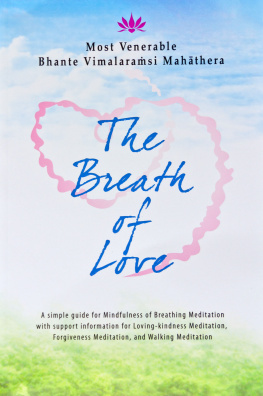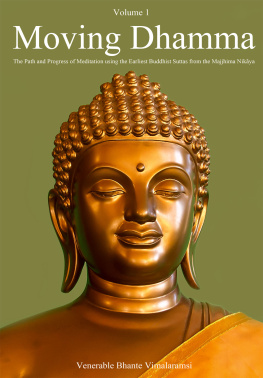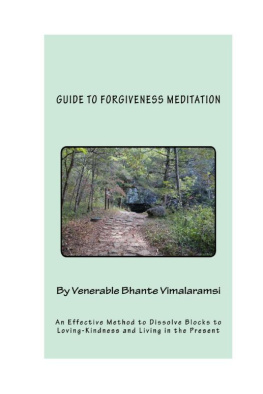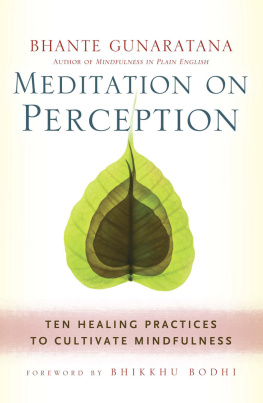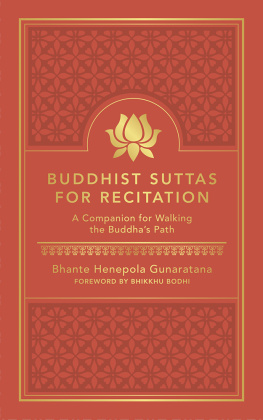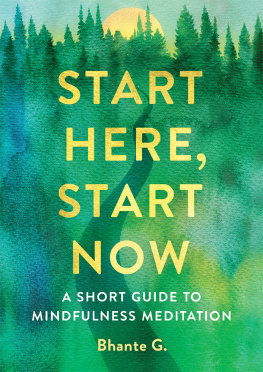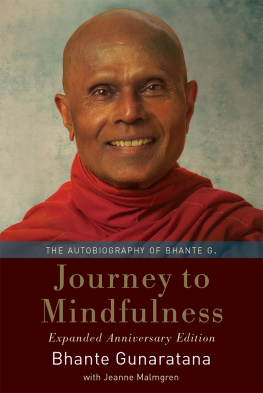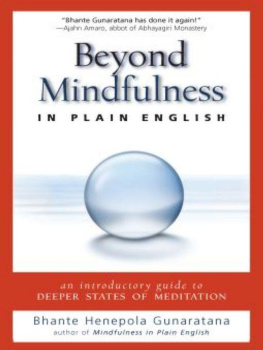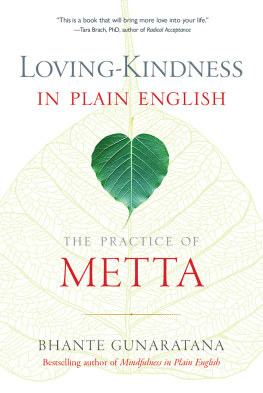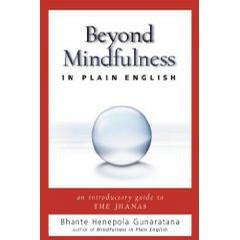The Breath of Love
Author
Most Venerable Bhante Vimalarasi Mahthera
Layout and Design
Vidi Daysati
Publisher
Ehipassiko Foundation
eBook
Jens Trger
Copyright Bhante Vimalarasi
ISBN 978-602-8194-49-5
1st print: Feb 2012 (eBook: 08 Oct 2012)
Dhamma Sukha Meditation Center
8218 County Road 204, Annapolis, MO 63620 USA
www.dhammasukha.org
Phone: +1 (573) 546-1214
Table of Contents
Foreword
The Buddhas Teachings are very suitable for any individual who is seeking peace and happiness, irrespective of any religious background. With this universal tradition you can practice sweet Loving-Kindness ( Mett in Pli) Meditation and become a true blessing to the whole world.
Loving-Kindness is the first of four sublime states of mind. The other sublime states of mind are: compassion, appreciative joy, and equanimity. Practicing these four sublime states of mind have limitless applications and boundaries in our every-day lives. For example, Loving-Kindness can be radiated towards yourself, towards family members, friends and co-workers. It can even be radiated toward all living beings under the sun and beyond. Whenever you wish someone Loving-Kindness you can bring them healing, peace, and happiness.
Loving-Kindness equally offers its sweet blessings on the pleasant and the unpleasant, on the rich and the poor, on the vicious and the virtuous, on females and males, as well as on human beings and non-human beings. This meditation instruction is simple to follow. It can be practiced by everyone who has the strong desire to experience more calm and joy than ever before. We all try in many different ways to pursue happiness. This is an unmistakable way to the true happiness that goes far beyond worldly materialistic types of happiness.
Some years ago in Malaysia I met the Ven. Vimalarasi and was so impressed by his style of teaching meditation that I invited this always smiling monk to come and teach meditation at the Washington Buddhist Vihra. He is not just another ordinary meditation teacher who follows the popular and modified meditation teachings of some Buddhist commentaries. This extraordinary teacher always refers to and uses the suttas as taught by the Lord Buddha in the original Pli Canon.
I see him as a serious follower of the Klma Sutta. This sutta suggests that we not follow anything without true investigation. He is continually checking and practicing to see if the teachings are in agreement with the spirit and the teachings of the suttas given by the Buddha.
Ven. M. Dhammasiri
President of the Washington Buddhist Vihra
Introduction
The most rewarding day of my life was the day I knew for certain that the Buddha-Dhamma was real! This Dhamma changed my life completely. It could change yours, too. Each day is a day of thanks for the Buddha, the Dhamma, and the Sagha, and for the privilege of being born within this Buddha Dispensation. What a wonderful opportunity and adventure!
The first edition of the little book The npnasati Sutta: A Practical guide for Breathing and Tranquil Wisdom Meditation was printed in 1995. Today the original text continues to spread worldwide. Hundreds of thousands of copies have been issued presently in 9 languages. Its even been used in universities abroad as the guide for learning meditation. Most amazing is that the book has spread on its own!
The author, Most Venerable Bhante Vimalarasi Mahthera, is a thirty plus year meditator who spent over twenty years following the commentarial explanations on how to meditate before looking in the suttas. Then he practiced according to the suttas and having seen for himself the results do not match the commentarial descriptions, Bhante put aside the commentary as he was advised to do by an elder monk. From that point on, he followed the Buddhas instructions as closely as possible.
For over sixteen years, he has dedicated himself to further investigations. He has been teaching anyone who would dare to ask the following questions directly: Did the Buddha actually find a way out of suffering in this life that was different from other meditation traditions of his time? If he did, how did he do it? Did he leave us precise instructions? Can it be done again in this day and time? Can this practice be taken into our daily lives? If so, what difference can it make?
Remember: Meditation is Life! Life is Meditation!
Following his enlightenment and full awakening, Buddha Gotama taught the Dhamma for a remarkable 45 years! This book is about the instructions he taught that have survived in the suttas, the discourses in the Pli Canon that were taught by the Buddha to his followers. It examines The npnasati Sutta from the Majjhima Nikya: the Middle Length Sayings.
This sutta teaches us Mindfulness of Breathing through Tranquil Wisdom Insight Meditation (TWIM). The instructions are repeated several times throughout the Pli Canon using the same identical words. This repetition confirms the importance of these instructions. Sometimes phrases in a sutta indicate the instructions over again.
It is said that there are more than forty objects of meditation that the Buddha taught. However, all these forms dealt with one goal in particular, that is, reaching a clear understanding of the impersonal process of Dependent Origination and the Four Noble Truths. This book is about using the breath as the object of the meditation to do just that.
The result of this practice is seeing for oneself the true nature of things. Students who have put forth a sincere effort to follow these instructions precisely have made remarkable strides in their meditation progress.
Bhante Vimalarasi brings these teachings to life using simple clear wording. To study with Bhante Vimalarasi is a refreshing rediscovery of our inherent altruistic joy and an introduction to what, according to the Buddha, a guiding teacher should actually be. The Buddha indicates that a guiding teacher should be a sincere conduit of the Buddhas words, emboldening his students to listen carefully, investigate fully, observe accurately, frequently question and confirm everything through personal experience.
Heres the amazing thing. What the Buddha did is not mythical, strictly religious, or philosophical. Its real! Ive been investigating it for over eleven years now. It is a methodical scientific experiment which uncovers how minds attention moves and leads to the discovery of the true nature of how everything works in life. It piques ones curiosity and alters our perspective. It becomes all too clear why this particular practice changed the world in the Buddhas time.
Buddhist meditation is the compassionate groundbreaking discovery leading to a doorway that reveals a pathway for transcendence to peace. To make peace a reality, mankind only needs to activate this practice. The doorway is available just as it was in the time of the Buddha! We have to choose to go through it.
Bhante has been bold in his approach to the practice and continues to reach into the heart of the Buddhas teaching with his own questions as he trains his students. He knows this is a journey you must personally take for yourself to reach a full understanding of this Dhamma. He sets the Dhamma Wheel in motion as you begin your journey and challenges you to make the effort to reach the destination for yourself.
If you work with Bhante as your guiding teacher, you will discover the true nature of suffering, how it is caused, and how to find great relief in this life. He offers you the next step each time you interview with him. Your progress is directly proportional to how well you follow the instructions, your accurate investigation through meditation, and your willingness to ask questions.

